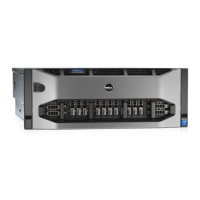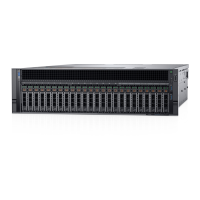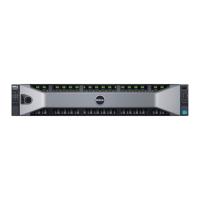• Populate all sockets with white release lever rst, then black, and then green.
• Populate the sockets by highest rank count in the following order — rst in sockets with white release levers, then black, and then
green. For example, if you want to mix single-rank and dual-rank RDIMMs, populate single-rank RDIMMs in the sockets with white
release tabs and dual-rank RDIMMs in the sockets with black release tabs.
• The memory conguration for each processor should be identical. For example, if you populate socket A1 and B1 for processor 1, then
populate socket C1 and D1 for processor 2, and so on.
• Memory modules of dierent sizes can be mixed provided that other memory population rules are followed (for example 8 GB and 16
GB memory modules can be mixed).
• Populate four DIMMs per processor (one DIMM per channel) at a time to maximize performance.
• If memory modules with dierent speeds are installed, they will operate at the speed of the slowest installed memory module(s) or
slower depending on system DIMM conguration.
Mode-specic guidelines
Four memory channels are allocated to each processor. The allowable congurations depend on the memory mode selected.
Advanced Error Correction Code (lockstep)
Advanced Error Correction Code (ECC) mode extends SDDC from x4 DRAM based DIMMs to both x4 and x8 DRAMs. This protects
against single DRAM chip failures during normal operation.
The installation guidelines for memory modules are as follows:
• Memory modules must be identical in size, speed, and technology.
• DIMMs installed in memory sockets with white release tabs must be identical and similar rule applies for sockets with black and green
release tabs. This ensures that identical DIMMs are installed in matched pairs - for example, A1 with A3, A2 with A4, A5 with A7, and so
on.
Memory optimized (independent channel) mode
This mode supports Single Device Data Correction (SDDC) only for memory modules that use x4 device width. It does not impose any
specic slot population requirements.
Memory sparing
NOTE
: To use memory sparing, this feature must be enabled in System Setup.
In this mode, one rank per channel is reserved as a spare. If persistent correctable errors are detected on a rank, the data from this rank is
copied to the spare rank, and the failed rank is disabled.
With memory sparing enabled, the system memory available to the operating system is reduced by one rank per channel. For example, in a
dual-processor conguration with sixteen 4 GB single-rank memory modules, the available system memory is: 3/4 (ranks/channel) × 16
(memory modules) × 4 GB = 48 GB, and not 16 (memory modules) × 4 GB = 64 GB.
NOTE
: Memory sparing does not oer protection against a multi-bit uncorrectable error.
NOTE: Both Advanced ECC/Lockstep and Optimizer modes support memory sparing.
Memory mirroring
Memory mirroring oers the strongest memory module reliability mode compared to all other modes, providing improved uncorrectable
multi-bit failure protection. In a mirrored conguration, the total available system memory is one half of the total installed physical memory.
Half of the installed memory is used to mirror the active memory modules. In the event of an uncorrectable error, the system switches over
to the mirrored copy. This ensures SDDC and multi-bit protection.
68
Installing and removing system components

